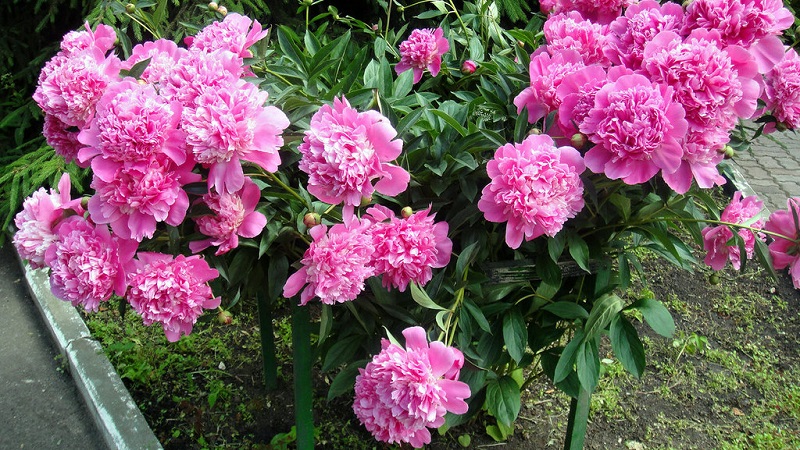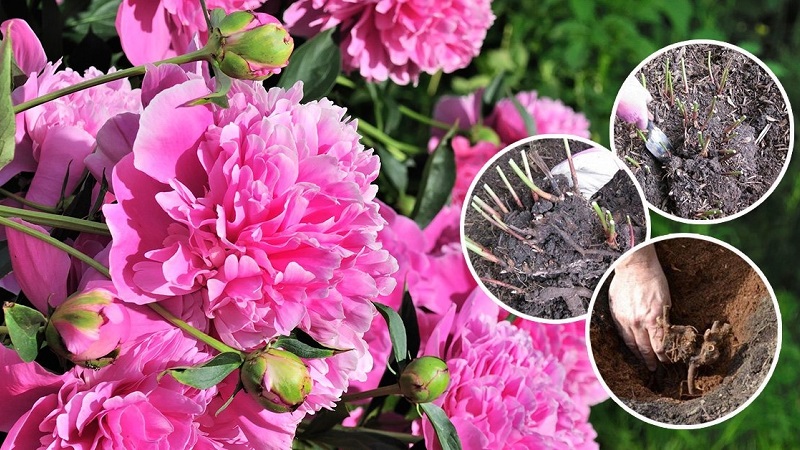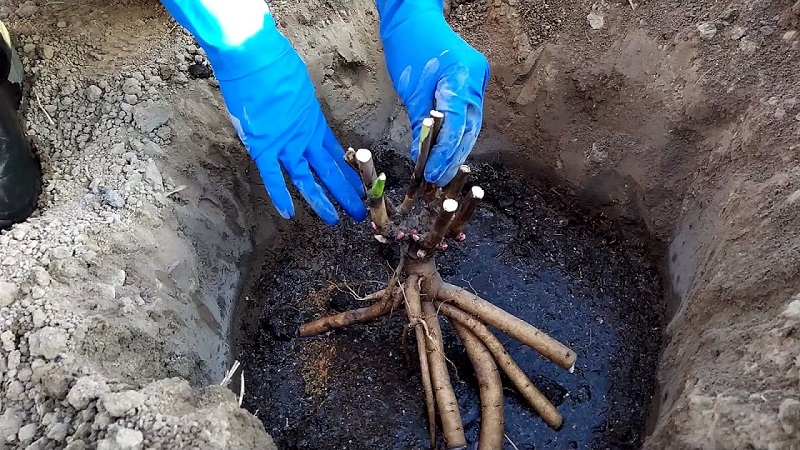When is it necessary to transplant peonies to another place in the summer and how to carry it out correctly
Peonies are as popular with flower growers as roses. Despite the simplicity in care, some summer residents cannot cope with these flowers. They either grow poorly or do not bloom at all. The reasons for this behavior of peonies are improper planting or lack of transplantation. In this article we will talk about transplanting peonies to another place in the summer: when can you transplant, how to do it correctly and take care of flowers after the procedure.
The content of the article
Is it possible to transplant peonies to another place in the summer
Peonies are considered centenarians and can grow in the same place for more than 10 years.... There are cases when plants have been growing in flower beds for 50 years and have delighted several generations of gardeners with abundant flowering.

But this is rather an exception to the rule than a pattern. Often, after 5-7 years, peonies begin to wither.: in the root collar slugs, worms and ants find refuge. Flower buds are laid deeper and deeper, as a result, flowers on the bushes appear only occasionally. This is a signal for the grower: the peonies need to look for another place.
Reference. On a bush that requires transplantation, spotted leaves appear, and in the area of the rhizome, the foliage turns yellow and dries.
3 main reasons for transplanting peonies in the summer:
- flowers are sick, roots are rotten, foliage and buds are affected by pests;
- bushes were in the shade due to overgrowth of shrubs and trees;
- the plant stopped blooming due to a decrease in soil nutrient levels.
Terms of summer transplant of peonies
It is recommended to transplant peonies after the buds have faded.... This happens at the end of summer, not earlier than August. During the summer period, the plant manages to stock up on nutrients and begins to prepare for wintering.
The most favorable period for the regions of the middle lane, according to experienced florists, - August 20 - September 20. In Siberia and the Urals, the timing is approximately the same - from mid-August to mid-September. In the south, peonies are transplanted from September 15 to October 25.
Auspicious days according to the lunar calendar in 2020:
- August - 20-26, 28, 29;
- September - 1-3, 7-12, 18-24, 28-30;
- October - 1, 4-6, 8, 10, 14, 17, 23-26.
Auspicious days according to the lunar calendar in 2021:
- August - 23, 27-31;
- September - 1-3, 8-13, 15, 16, 19, 20, 21, 25, 29, 30;
- October - 3, 4, 7-13, 16-21, 23-26.
Interesting on the site:
Why do you need to prune a climbing rose after flowering
We take care of roses in summer so that they bloom luxuriantly and for a long time
Choosing a new location
When choosing a new place for peonies, it is recommended to take into account the level of lighting.: it is important that the site was sunny or in partial shade. The place should be protected from drafts and gusty winds. Florists also take into account the location of groundwater. Peonies do not grow well in too wet and swampy areas, which leads to decay of the root system. Therefore, the place for the transplant is chosen on an elevated site.
The soil must be loose and fertile, ideally - loam with neutral acidity. If necessary, the soil is fertilized with rotted manure and peat, river sand is introduced into too clayey and clogged soil.
It is not recommended to plant peonies under trees with a spreading crown. or overgrown shrubs, since the flowers will be constantly in the shade.
Reference.Peonies go well with lilies, delphiniums, clematis, phlox, irises.
Preparing a new transplant site
The new location begins to be prepared about a month before the proposed flower transplant..
Pits 60-70 cm deep are dug on the site. The bottom is filled with a layer of drainage (broken brick, expanded clay, pebbles), nutritious soil is poured on top, which can be purchased in shops for gardeners or prepared by yourself.
In a large container 10 liters of peat, compost, river sand are mixed, 200 g of wood ash and 50 g of superphosphate are added.

Preparation of peonies
Before you dig out the peony bush, it is recommended to cut the stems almost level with the ground... Pruning is done with a sharpened secateurs. It is not necessary to completely cut the foliage as it provides the plant with nutrients.
The bush is dug in with pitchforks from all sides and gently pry... Some of the roots will inevitably break off, but this will not affect the state of the plant. Then, with both hands, they grab the stems, swing the bush in different directions and carefully take out the rhizome along with the earthen lump. The roots are freed from the soil with the help of water from a hose and left for 3-5 hours in the shade, so that they wilt a little and become elastic. This will make it easier to divide the bush.
Division is performed manually, if possible, or cut the rhizome with a knife, pretreated with medical alcohol or potassium permanganate. When dividing, it is important not to damage the kidneys.
3-5 buds are left on each division, and the length of the roots should be 15-20 cm... Pruning too long for ease of planting in a hole.
In the process of division the rhizome is carefully examined from all sides, areas with traces of rot and mold are cut off... Slices are sprinkled with crushed coal or smeared with brilliant green. Delenki can be dipped for half an hour in a disinfecting solution of potassium permanganate or the drug "Maxim". To stimulate root formation, additionally use "Heteroauxin" or "Kornevin".
There is another way to protect the roots during transplantation. - processing with clay talker. To do this, clay is mixed with water to the consistency of thick sour cream, copper sulfate (50 g per 10 l) is added and the delenki are dipped into this mixture.

How to transplant peonies to a new place
If the bush is transplanted without dividing, the roots do not need to be washed.... The rhizome is dug up and carefully transferred to the pit. The buds are buried no more than 5 cm. The soil is leveled and watered with water with the addition of potassium permanganate.
The delenka is placed in the center of the prepared hole and covered with a layer of clean soil.... Small delenki are planted vertically, large ones at a slight slope. The land is watered with clean, settled water and mulched with sawdust, peat or bark.
Mistakes to Avoid
Reasons for the lack of flowering after transplant:
- Excessive deepening of the rhizome. Peonies do not like deep planting and begin to rot. The optimum soil level is 3-5 cm from the root bud.
- Wrong choice of place for transfer. Peonies love light and do not develop well in the shade.
- Peonies grow poorly in acidic soil. To normalize acidity, dolomite flour or slaked lime (400-500 g per m²) is added to the soil.
- When transplanting, too small divisions were used, which begin to bloom only 3-4 years after planting.
- Insufficient watering or excess moisture.
- Peonies overfed with nitrogen actively grow green mass, but do not give flowers.
Read also:
Post-transplant care
Transplanted peonies need more attention florist. The degree of survival in a new place depends on compliance with the rules of agricultural technology.
The first 2 weeks do not touch the delenki and give them time to adapt... Plantings are watered abundantly 1-2 times a week. The roots should receive a sufficient amount of moisture, and with frequent surface watering, only the top layer of the soil is moistened.5-15 liters of settled water are poured under each bush, depending on the size of the bush. In dry weather, the frequency of watering is increased, and the ground under the bushes is loosened.
Nitrogen should be abandoned, because it causes active growth of green mass, and the plant does not have time to prepare for wintering. Potash and phosphorus fertilizing is applied only 2-3 years after transplantation.
Preparation for wintering begins with the onset of the first cold weather... The bushes are completely cut off, covered with peat, straw, dry foliage. In areas with severe and little snowy winters, peonies are covered with non-woven fiber and spruce branches.

Tips from experienced florists
Tips from experienced florists to help beginners to maintain the health, longevity and lush bloom of peonies:
- The best place to plant is an open and sunny area on a hill. In a dark and damp place, the flowers begin to rot.
- A gusty wind and a draft for peonies are worse than frost, so the flower garden is located near fences and buildings.
- It is not recommended to plant peonies under tall trees with a spreading crown and large shrubs, in the shade of which the flower hardly blooms.
- Peonies love fertile, breathable soil with neutral acidity. The more nutrients in the soil, the more magnificently the bushes bloom.
- When transplanting, it is not recommended to deepen the growth buds. Otherwise, there will be no lush flowering.
- After planting the parcels or bushes, the soil is lightly pressed with your hands, but in no case with your feet, so as not to damage the growth buds.
- When planting in hot weather, the trunk circle is mulched with peat or straw to retain moisture in the soil and prevent the roots from drying out.
- For watering peonies use water with the addition of "Kornevin" to stimulate root formation.
- The first 2-3 years after planting, peonies rarely indulge in lush flowering. To stimulate bud formation, it is recommended to remove flower buds in the first year of flowering so that the bush spends less effort on building up roots. The buds are removed from the sides of the bush.
- The buds of terry varieties of peonies for a bouquet are cut half-open, not terry - at the stage of a colored bud. The flowers are cut in the morning, so they last longer in the vase.
Conclusion
Peonies can grow in the same place for years or even decades. However, flower growers are advised to move the flower to a new location every 5-7 years. Yellowing of the lower leaves, spots on their surface, rare flowering indicate the need for transplanting.
If peonies grow in the shade of tall trees and large shrubs, they receive little sunlight and react with no buds. On depleted soil, the flowers do not receive enough nutrition and wither. These are all good reasons to move the plant to a more favorable location.